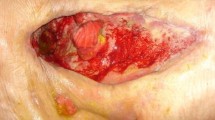Abstract
Active drains, which work from negative pressure effect, are commonly used to drain closed airtight wounds. Higher negative pressure is used in vacuum-assisted wound closure (VAC®) (usually −125 mmHg) dressings and in Redivac® system (usually −300 mmHg). As far as we know, combinations of Redivac® and VAC® have not been used. The authors describe a novel combination using the sponge of the VAC® dressing and sealed Redivac® system to drain an open rectal wound, consequence of a perforation after stapled haemorrhoidopexy.

Similar content being viewed by others
References
Mees ST, Palmes D, Mennigen R, Senninger N, Haier J, Bruewer M (2008) Endo-vacuum assisted closure treatment for rectal anastomotic insufficiency. Dis Colon Rectum 51:404–410
Nagell CF, Holte K (2006) Treatment of anastomotic leakage after rectal resection with transrectal vacuum-assisted drainage (VAC). A method for rapid control of pelvic sepsis and healing. Int J Colorectal Dis 21:657–660
Ravo B, Amato A, Bianco V et al (2002) Complications after stapled hemorrhoidectomy: can they be prevented? Tech Coloproctol 6:83–88
Shao WJ, Li GC, Zhang ZH, Yang BL, Sun GD, Chen YQ (2008) Systematic review and meta-analysis of randomized controlled trials comparing stapled haemorrhoidopexy with conventional haemorrhoidectomy. Br J Surg 95:147–160
Pescatori M, Gagliardi G (2008) Postoperative complications after procedure for prolapsed hemorrhoids (PPH) and stapled transanal rectal resection (STARR) procedures. Tech Coloproctol 12:7–19
Burch J, Epstein D, Baba-Akbari A et al (2008) Stapled haemorrhoidectomy (haemorrhoidopexy) for the treatment of haemorrhoids: a systematic review and economic evaluation. Health Technol Assess 12:1–193
Molloy RG, Kingsmore D (2000) Life threatening pelvic sepsis after stapled haemorrhoidectomy. Lancet 355:810
Weidenhagen R, Gruetzner KU, Wiecken T, Spelsberg F, Jauch KW (2008) Endoluminal vacuum therapy for the treatment of anastomotic leakage after anterior rectal resection. Rozhl Chir 87:397–402
van Koperen PJ, van Berge Henegouwen MI, Rosman C et al (2008) The Dutch multicenter experience of the Endo-Sponge treatment for anastomotic leakage after colorectal surgery. Surg Endosc (in press)
Author information
Authors and Affiliations
Corresponding author
Rights and permissions
About this article
Cite this article
Durai, R., Ng, P.C.H. Perirectal abscess following procedure for prolapsed haemorrhoids successfully managed with a combination of VAC sponge and Redivac systems. Tech Coloproctol 13, 307–309 (2009). https://doi.org/10.1007/s10151-009-0503-5
Received:
Accepted:
Published:
Issue Date:
DOI: https://doi.org/10.1007/s10151-009-0503-5




